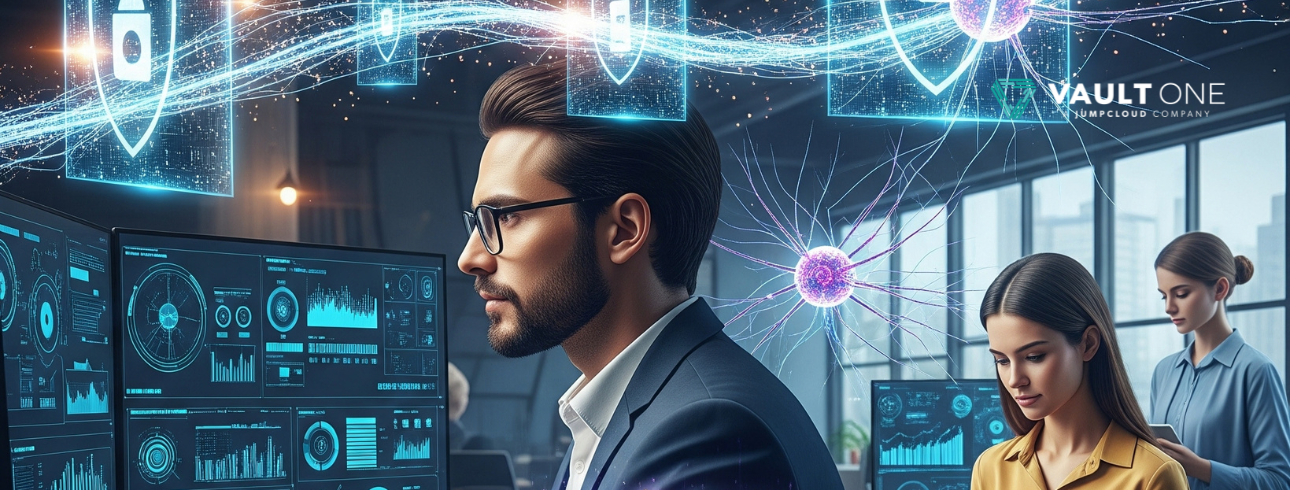Artificial Intelligence in Cybersecurity: The Intelligent Shield of Digital Protection
- Updated at
- By Diandra Mansano
- PAM - Privileged Access Management, Security

The Invisible War and the Rise of AI
In an increasingly interconnected digital world, the rapid evolution of cyber threats poses unprecedented challenges to organizations and individuals. Traditional security measures, though essential, often struggle to keep pace with the sophistication and speed of modern attacks. This escalating arms race between attackers and defenders has created a critical need for more proactive, adaptive, and intelligent defense mechanisms. Enter Artificial Intelligence (AI). Once a concept confined to science fiction, AI is now rapidly transforming the cybersecurity landscape, offering innovative solutions to detect, prevent, and respond to threats with unparalleled efficiency. This article delves into the profound impact of AI on cybersecurity, exploring how this intelligent shield is redefining digital protection, from enhancing threat detection to automating incident response, and ultimately empowering a more resilient defense against the ever-evolving cyber threats.
I. AI: Our Ally and Adversary in the Digital Battle
AI in cybersecurity has two faces: one that intelligently protects us, and another that, in the wrong hands, can create even greater threats.
A. AI as Defense: The Guardian That Never Sleeps
The great revolution of AI in security lies in its ability to overcome human limitations and reactive defenses
Detecting Advanced Threats and Anomalies:
- Behavioral Learning: Forget “virus lists.” AI learns the “normal” behavior of your network, users, and systems. If something drastically deviates from this pattern—an unexpected access, an abnormal volume of transferred data—AI triggers an alert. This is crucial for finding unknown threats (zero-day) or insider attacks that traditional systems wouldn’t see.
- Predictive Analytics: By analyzing past and present data, AI can predict where and how the next attacks might occur. It can identify new malicious internet addresses, newly created phishing sites, or even attack patterns that are just beginning to emerge.
- Malware Classification: With Deep Learning, AI can analyze the code of malicious software at a much more detailed level. It identifies threat families and malware that constantly change their “appearance” (polymorphic) to evade detection, acting faster and with greater precision than traditional antivirus.
Automation and Security Orchestration, Automation, and Response (SOAR):
- AI is the driving force behind SOAR (Security Orchestration, Automation, and Response) platforms. It automates repetitive and time-consuming tasks for analysts, such as collecting security logs, analyzing events, and even providing a “first response” to an attack.
- By connecting alerts from different systems (like firewalls and endpoint protection software), AI can identify real, urgent incidents. This reduces false positives and frees human analysts to focus on more complex investigations. For example, it can automatically isolate a compromised computer or block a dangerous website.
Vulnerability Analysis and Risk Management:
- AI systems can continuously scan vast networks and program code for weaknesses. They help prioritize vulnerabilities that are most likely to be exploited and would cause the greatest damage, allowing security teams to allocate resources where they matter most.
- AI can also simulate attacks, showing where your infrastructure might fail before a real cybercriminal finds it.
Predictive Threat Intelligence:
- AI processes and understands mountains of threat intelligence data from various sources (news, reports, even the dark web). By finding trends, emerging attacker groups, and their tactics, AI offers predictions that allow your organization to prepare before being attacked.
AI-Powered Application Security:
In software development, AI improves tools that find security flaws in code (SAST and DAST). It learns what secure code is and what is vulnerable, finding errors faster and with fewer unnecessary alerts during program creation.
Enhanced Authentication and Access Control:
- Behavioral Biometrics: AI analyzes how you type, how you move your mouse, your location, and other patterns. If your behavior deviates from the norm, it can request an extra verification or flag suspicious access, even if the password is correct. This adds a powerful security layer to Multi-Factor Authentication (MFA).
- Access Risk Analysis: AI evaluates the risk associated with each access request in real-time, considering factors like location, device, time of day, and access history. It can intelligently allow or deny access dynamically.
More Effective Security Awareness:
- AI-powered tools can create personalized and adaptive security awareness training programs, identifying the highest-risk areas for each employee based on their behavior and interaction history with phishing simulations, for example. This makes training more effective and engaging.
B. AI as a Threat: The Weapon in the Wrong Hands
Unfortunately, AI’s ability to automate, scale, and personalize is equally appealing to cybercriminals.
AI-Enhanced Social Engineering Attacks:
- “Perfect” Phishing and Spear-Phishing: Advanced AI models (like Large Language Models – LLMs) can generate incredibly convincing phishing emails and text messages (smishing). They use perfect grammar, personalized context, and even mimic the writing style of people you know, making it very difficult for victims to spot the fraud.
Polymorphic and Evasive Malware:
- AI can be used to create malware that constantly modifies itself (polymorphism), evading detection by traditional signature-based antivirus. This continuous mutation capability makes combating these threats much harder.
- Adversarial Attacks: Adversaries can “trick” AI defense systems by adding small, imperceptible changes to attack data, causing the AI to classify them as “safe,” allowing the threat to pass undetected.
Automation and Escalation of Attacks:
- Intelligent Bots: AI can be used to create bots that scan networks more efficiently, find vulnerabilities, and launch large-scale attacks (like password brute-forcing attempts) much faster and more adaptively.
- Vulnerability Exploitation: AI accelerates the process of discovering and exploiting vulnerabilities, allowing attackers to automate the search for and attack of vulnerable systems.
AI's Own Weaknesses and Biases:
- AI models are only as good as the data they are trained on. If the training data is flawed or incomplete, the model can have “blind spots” or make errors, which can be exploited by attackers.
- The difficulty in understanding how some AI models reach their decisions (the “black box problem”) can make it challenging to identify and correct their own vulnerabilities.
Security of AI Infrastructure Itself:
AI systems themselves and the data used to train them become attractive targets. Compromising an AI model can lead to manipulating its results (poisoning) or exfiltrating sensitive data used in training.
II. The Types of AI and Machine Learning Driving Cybersecurity
AI is not a single technology but a collection of approaches and algorithms applied in different ways within cybersecurity.
1. Supervised Machine Learning:
- How it works: The model learns from “labeled” examples (e.g., “this is spam,” “this is not spam”). It’s like teaching a child by showing pictures and telling them what each one is.
- Applications: Spam detection, malware identification, phishing recognition.
2. Unsupervised Machine Learning:
- How it works: The model explores unlabeled datasets to find hidden patterns, clusters, or anomalies. It’s like giving a child a pile of toys and asking them to organize them without instructions.
- Applications: Finding abnormal network behavior, clustering infected computers that act similarly (botnets), discovering new types of malware.
3. Reinforcement Learning:
- How it works: The model learns by trial and error, receiving “rewards” for correct actions and “penalties” for mistakes. It’s like teaching a dog with treats.
- Applications: Optimizing real-time defenses, simulating attacks and defenses for autonomous system training. Still primarily a research area.
4. Natural Language Processing (NLP):
- How it works: Allows machines to understand and generate human language.
- Applications: Analyzing free-text security logs, detecting malicious intent in emails (social engineering), analyzing threat intelligence from textual sources, or even in security chatbots.
5. Neural Networks and Deep Learning:
- How it works: A subfield of machine learning inspired by the structure and function of the human brain. Deep neural networks (with many layers) can learn complex, hierarchical representations of data.
Applications: Advanced malware detection (analyzing binary patterns), intrusion detection, facial/voice recognition for authentication, analysis of encrypted network traffic, fraud detection.
III. Challenges: The Reality of AI in Cybersecurity
Despite its vast potential, implementing AI in cybersecurity is not without complex obstacles.
1. Data Quality and Volume:
- “Garbage In, Garbage Out”: The effectiveness of any AI model critically depends on the quality, quantity, and relevance of its training data. Bad data leads to bad AI, with many false positives or, worse, failures to detect real threats.
Labeling Data: For supervised AI learning, labeling large volumes of cybersecurity data (identifying what is “normal” vs. “malicious”) is an expensive, time-consuming task requiring human expertise.
2. Cost and Complexity:
- Developing and maintaining robust AI systems requires significant investment in hardware (powerful processors), software, and, most importantly, highly specialized professionals.
- The complexity of managing and maintaining these systems, which need to be constantly retrained and adjusted to adapt to new threats, is a challenge for many organizations.
3. Talent Shortage:
There’s a global shortage of professionals with expertise in both AI/Data Science and cybersecurity simultaneously. The combination of skills in data science, machine learning, software engineering, and deep security knowledge is rare.
4. The "Black Box" of AI (Explainable AI - XAI):
Many advanced AI models, especially the more complex ones, cannot explain how they arrived at a particular decision. In security, where every alert can have serious consequences, it’s crucial for analysts to understand the “why” to trust the system and investigate correctly. This is known as Explainable AI (XAI), an important research field.
5. Resistance to Change and Trust:
Security professionals may be skeptical of full automation or decisions made solely by machines, especially in critical situations. Building trust in AI systems requires transparency, continuous validation, and demonstrated tangible results.
6. Privacy and Regulation:
AI systems in cybersecurity process large volumes of data, which may include sensitive information about users and network behavior. This raises significant privacy concerns and compliance issues with laws like LGPD and GDPR, requiring AI to be designed with privacy from the outset (Privacy by Design).
7. Attacks Against AI Itself:
AI models themselves can be targets. Hackers can try to “poison” training data to manipulate AI behavior, or “trick” AI with altered input data so that it fails to detect a real attack. Defending AI from AI is a critical new field of study.
IV. Strategies: How to Supercharge Your Cybersecurity with AI
To maximize the benefits of AI and mitigate its risks, organizations must adopt a strategic and multifaceted approach.
1. Human-Machine Partnership: Augment, Don't Replace:
AI should be seen as an ally that augments human capabilities. It’s excellent for processing large volumes of data, identifying patterns, and automating repetitive tasks. Humans, in turn, are irreplaceable for complex decision-making, contextual analysis, creative problem-solving, and empathy. Human-in-the-Loop collaboration is the key to success.
2. Continuous Investment in R&D:
AI technology and threats evolve rapidly. Organizations must continuously invest in R&D to keep their AI systems updated, adapted to new dangers, and resilient to sophisticated attacks.
3. Collaboration and Information Sharing:
Cybersecurity is a team sport. Sharing threat intelligence, attack data, and discoveries about AI use by cybercriminals among businesses, governments, and the research community is vital to developing more effective defenses for everyone.
4. Education and Talent Development:
It is imperative to invest in training and upskilling cybersecurity professionals with data science and machine learning skills. Building multidisciplinary teams with expertise in both AI and security is the way forward.
5. Security "by Design" for AI Systems:
Security must be incorporated from the very beginning of any AI system’s development (Security by Design and Privacy by Design). This includes protecting training data, continuously validating the model, and implementing techniques to mitigate adversarial attacks.
6. Focus on Data Quality:
Establish robust processes for data collection, cleansing, labeling, and curation to ensure that AI models are trained with accurate information that truly represents the real digital environment.
V. The Future with AI: Self-Defense and a Step Ahead of Attacks
The future of cybersecurity will undoubtedly be shaped by Artificial Intelligence. We are moving towards a scenario where security systems will be increasingly autonomous, predictive, and adaptable in real-time.
- Predictive and Proactive AI: Defenses will shift from a reactive stance to a proactive one, where AI will be able to predict and prevent attacks even before they begin, by analyzing adversary behavior and potential weaknesses.
- Advanced Automation: More complex analysis and incident response tasks will be automated, freeing security analysts to focus on strategic threats and continuously improving the defense posture.
- Autonomous Defense: In a more distant future, we may see nearly fully autonomous security systems capable of detecting, analyzing, and responding to threats in milliseconds, outpacing modern attacks. This will require a much higher level of AI trust and “transparency.”
- Emerging Challenges: New challenges will arise, such as the interaction between AI and quantum computing. Post-quantum cryptography, for example, is an area where AI can play a role in identifying and implementing new security algorithms.
- The AI “Arms Race”: The competition between offensive and defensive uses of AI will continue to intensify. The ability to innovate and adapt rapidly will be crucial for both sides in this technological battle.
Conclusion: Embracing AI for a Safer Digital Tomorrow
Artificial Intelligence is not just a technological tool; it is a catalyst profoundly transforming cybersecurity. While it presents its own challenges and risks, its potential to enhance threat detection, automate responses, and provide predictive insights is undeniable and revolutionary.
For organizations at the forefront of digital security, like VaultOne (now part of JumpCloud), the strategic integration of AI, especially in the field of Privileged Access Management (PAM), is a crucial step. By combining PAM expertise with the power of AI, the unified platform offers a more intelligent, robust, and adaptable defense.
The future of cybersecurity is not about AI replacing humans, but about an intelligent collaboration between them. It’s about empowering defenders with tools that expand their capabilities, allowing them to face increasingly sophisticated adversaries. By embracing Artificial Intelligence strategically and responsibly, we can build a safer and more resilient digital environment for everyone.



